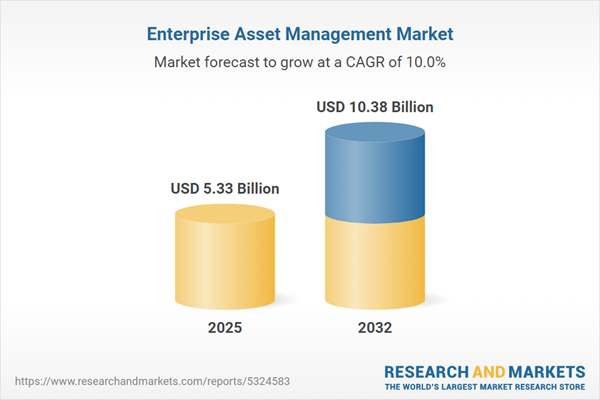Speak directly to the analyst to clarify any post sales queries you may have.
The enterprise asset management market is rapidly evolving as organizations adopt advanced digital solutions and strategic frameworks to increase operational resilience, optimize lifecycle cost, and align with regulatory and sustainability mandates. Modern asset decision-makers are navigating a landscape marked by complexity, requiring data-driven approaches and agile execution to secure competitive advantage.
Market Snapshot: Enterprise Asset Management Demand and Growth
The enterprise asset management market grew from USD 4.85 billion in 2024 to USD 5.33 billion in 2025. Fuelled by a robust CAGR of 9.97%, the market is projected to reach USD 10.38 billion by 2032. This momentum reflects escalating needs for condition-based monitoring, predictive maintenance, and integrated digital platforms across a spectrum of industries and regions.
Scope & Segmentation: Comprehensive Market Coverage
- Organization Size: Large Enterprises, Small and Medium Enterprises (including Medium Enterprises, Small Enterprises)
- Deployment Mode: Cloud (Private Cloud, Public Cloud), On Premise
- Component: Services, Software
- Asset Type: Facilities Assets, Infrastructure Assets, Production Assets, Transportation Assets
- Industry Vertical: Energy and Utilities, Healthcare, Manufacturing, Mining and Metals, Oil and Gas, Transportation and Logistics
- Regional Coverage: Americas (United States, Canada, Mexico, Brazil, Argentina, Chile, Colombia, Peru), Europe, Middle East & Africa (including United Kingdom, Germany, France, Russia, Italy, Spain, Netherlands, Sweden, Poland, Switzerland, United Arab Emirates, Saudi Arabia, Qatar, Turkey, Israel, South Africa, Nigeria, Egypt, Kenya), Asia-Pacific (China, India, Japan, Australia, South Korea, Indonesia, Thailand, Malaysia, Singapore, Taiwan)
- Key Companies: International Business Machines Corporation, SAP SE, Oracle Corporation, Infor, Inc., IFS AB, Schneider Electric SE, ABB Ltd, General Electric Company, Hexagon AB, Bentley Systems, Incorporated
Key Takeaways for Senior Decision-Makers
- The shift toward integrated lifecycle management is transforming asset management from a tactical function to a strategic discipline that drives business continuity and differentiation.
- Digitalization is enhancing maintenance and reliability through predictive analytics, sensor integration, and scalable cloud platforms, enabling more efficient resource allocation and improved asset performance.
- Workforce dynamics, including the retirement of experienced technicians, are prompting organizations to invest in digital twins, knowledge capture systems, and remote support technologies to retain institutional expertise.
- Sustainability initiatives are prompting firms to extend asset life, optimize energy use, and embed circular economy strategies within capital procurement and decommissioning processes.
- Competitive vendors are succeeding by offering extensible platforms, domain expertise, and outcome-oriented service models that enable modular deployment and continuous improvement.
- Clear governance frameworks, robust data strategies, and cross-functional teams are essential for aligning asset management with corporate financial and risk objectives.
Tariff Impact: Sourcing, Strategy, and Risk Management
Recent tariff actions have compelled organizations to reevaluate sourcing strategies, with procurement teams pursuing supplier diversification and nearshoring to manage cost volatility and ensure supply chain continuity. Maintenance departments are investing in in-house refurbishment and standardized spares, mitigating dependency on single-origin suppliers. These conditions drive increased emphasis on scenario planning, predictive diagnostics, and risk assessment within capital decision-making.
Methodology & Data Sources
This research integrates primary interviews and workshops with asset managers and procurement professionals, supplemented by extensive reviews of technical literature, regulatory guidance, and industry reports. Data triangulation and cross-validation ensure that insights reflect real-world practices and address variability in regional and organizational maturity.
Why This Report Matters: Actionable Insights for Progress
- Uncovers how technological advances, regulatory pressure, and workforce shifts are redefining asset strategies, enabling leaders to craft future-ready operations.
- Offers segmentation analysis that supports tailored investment, deployment, and procurement decisions aligned with organization size, region, and industry needs.
- Equips executives with practical recommendations to enhance data governance, supply chain resilience, and sustainable asset management.
Conclusion
Enterprise asset management is now a strategic lever for resilience and alignment with evolving business imperatives. Forward-looking organizations who adopt integrated, data-driven approaches are better positioned to optimize performance and navigate the complexities of the global market.
Additional Product Information:
- Purchase of this report includes 1 year online access with quarterly updates.
- This report can be updated on request. Please contact our Customer Experience team using the Ask a Question widget on our website.
Table of Contents
3. Executive Summary
4. Market Overview
7. Cumulative Impact of Artificial Intelligence 2025
List of Figures
Samples

LOADING...
Companies Mentioned
The key companies profiled in this Enterprise Asset Management market report include:- International Business Machines Corporation
- SAP SE
- Oracle Corporation
- Infor, Inc.
- IFS AB
- Schneider Electric SE
- ABB Ltd
- General Electric Company
- Hexagon AB
- Bentley Systems, Incorporated
Table Information
| Report Attribute | Details |
|---|---|
| No. of Pages | 183 |
| Published | October 2025 |
| Forecast Period | 2025 - 2032 |
| Estimated Market Value ( USD | $ 5.33 Billion |
| Forecasted Market Value ( USD | $ 10.38 Billion |
| Compound Annual Growth Rate | 9.9% |
| Regions Covered | Global |
| No. of Companies Mentioned | 11 |









